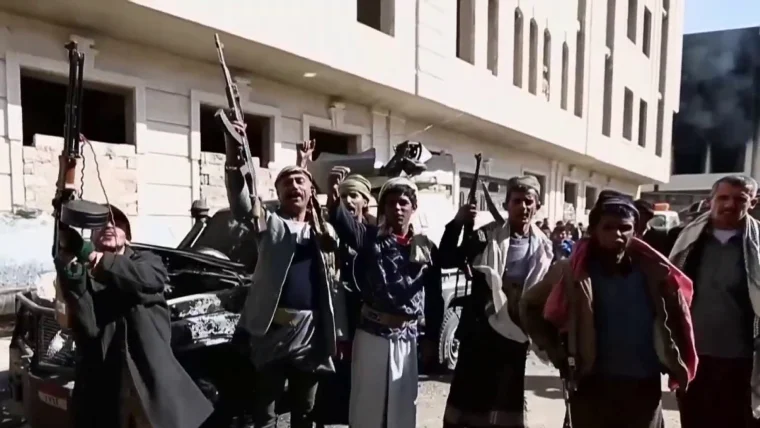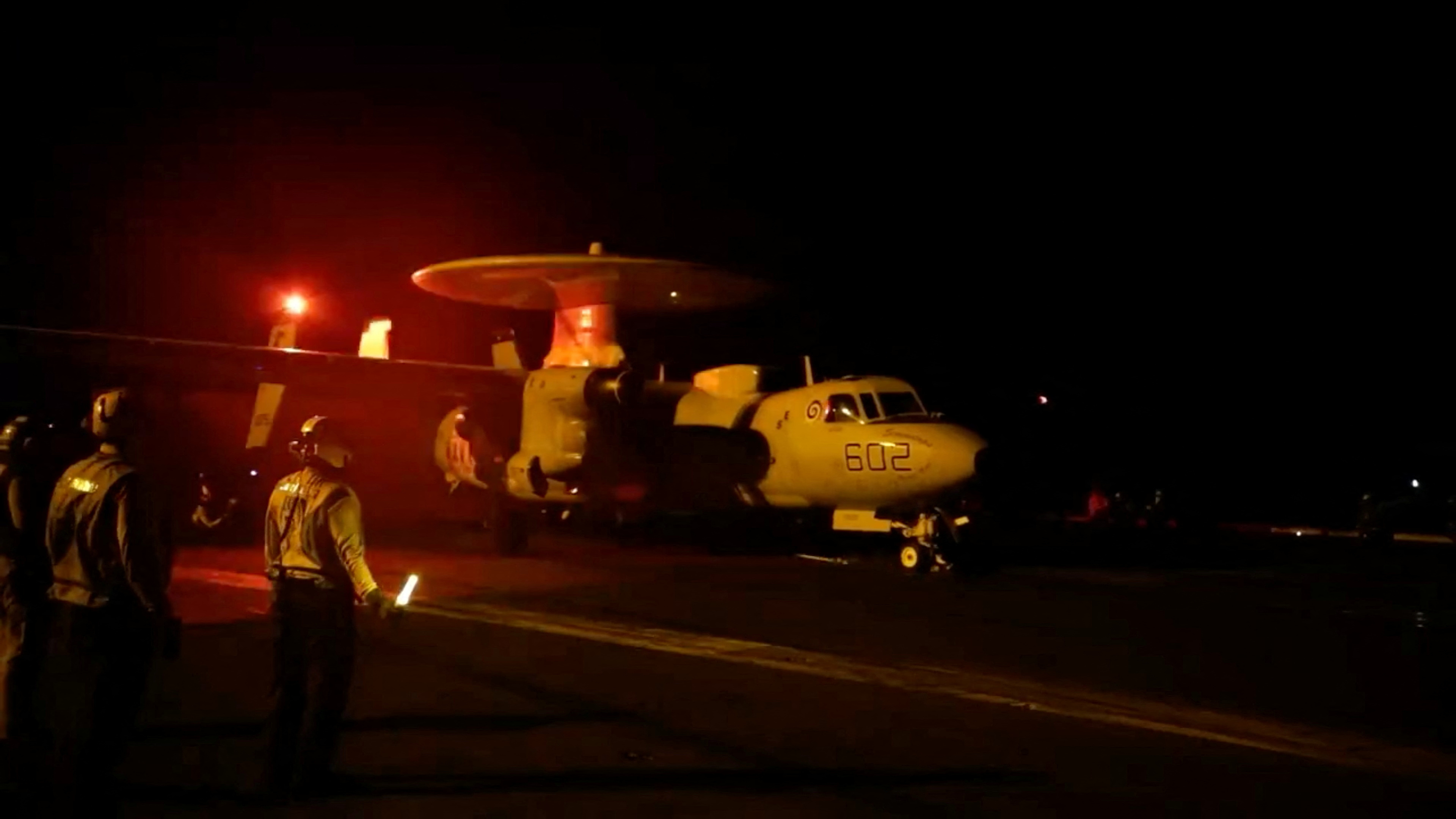
Following the Biden administration’s and its allies’ warning that the Iran-backed militant group would suffer the consequences of repeated drone and missile attacks on commercial shipping in the Red Sea, On Thursday, the armed forces of the US and the UK began attacking several Houthi locations in Yemen that they control. This marked a significant response.
“In direct response to unprecedented Houthi attacks against international maritime vessels in the Red Sea,” according to President Joe Biden, he ordered the strikes.
“Today, under my command, U.S. military forces—along with the United Kingdom and with assistance from Australia, Bahrain, Canada, and the Netherlands—successfully carried out strikes against several targets in Yemen that the Houthi rebels were using to jeopardise freedom of navigation in one of the most important waterways in the world,” the president stated in a White House statement.
“Not hesitate to direct further measures to protect our people and the free flow of international commerce as necessary,” Biden went on to say.
According to a statement from US Air Forces Central Commander Lt. Gen., US and coalition forces “executed deliberate strikes on over 60 targets at 16 Iranian-backed Houthi militant locations, including command and control nodes, munitions depots, launching systems, production facilities, and air defence radar systems.”
Alex Grynkewich. He said that more than a hundred precision-guided weapons “of various types” were employed.
The strikes are an indication of the rising global concern about the danger to one of the most important rivers in the world. The US had been attempting for weeks to avoid going directly on Yemen due to the possibility of escalation in an already tense area while the Israel-Hamas war rages on, but the coalition was forced to act due to the Houthi attacks on international commerce.
This is the first known hit against the Houthis in Yemen, even though the US has launched strikes against Iranian proxies in Iraq and Syria since the start of the Gaza War.
Tomahawk missiles and aircraft planes carried out the strikes. According to a US official who spoke to CNN, more than a dozen Houthi sites were hit by missiles launched from air, surface, and submarine platforms. These targets were picked because they may weaken the Houthis’ ongoing attacks on ships in the Red Sea.
Among them were radar systems, drone storage and launch sites, ballistic missile storage and launch sites, and cruise missile storage and launch sites.
A second US official stated that the USS Florida, a guided missile submarine, participated in the strike on Yemen after it entered the Red Sea on November 23. According to the official, the sub-launched Tomahawk land-attack missiles, much as the surface ships that took part in the attack.
On Thursday night, a top military officer told reporters that while he was unable to give a precise figure for the portion of Houthi assets destroyed in the attacks, it was “significant.” He continued by saying that the targets were destroyed “and also to minimise collateral damage” using precision-guided bombs.
“We did not intend to attack civilian population centres in any way. We were using precision weapons to target very precise capabilities at very specific areas,” the person stated.
Although preparations have been on for some time, the Houthi attacks on Red Sea ships on Tuesday was the last straw that led to Biden approving the US to proceed with Thursday’s strikes, a senior US official told CNN.
The strikes occurred while Secretary of Defence Lloyd Austin was still in the hospital as a result of post-prostate cancer surgery difficulties. According to a senior Defence source, Austin used “a full suite of secure communications” to direct and oversee the strikes in real-time from the hospital.

Biden has been evaluating the possibility of an intensifying Middle East crisis about possible operations against Houthi locations in Yemen over the last few weeks. His main reason for being reluctant to provide direct orders has been his fear of becoming more closely involved in a fight that is only going to become worse, a situation that US officials think Iran may eventually want.
However, the repeated Houthi attacks on international maritime lines in the southern Red Sea were unacceptable, as stated by the White House. Some of the biggest shipping firms in the world were compelled by the assaults to steer clear of the canal and instead circumnavigate Africa, adding thousands of miles to their international shipping routes.
Before Thursday’s attack, Iran “has a role to play” in persuading the Houthis to cease their “reckless, dangerous, and illegal activity,” according to Pentagon spokesperson Maj. Gen. Pat Ryder. He warned them that “there will be consequences” if they didn’t.
For weeks, US Navy ships in the region have been intercepting and shooting down drone and missile launches by the Houthis, a Shia political and military group backed by Iran that is engaged in a civil war in Yemen against a coalition led by Saudi Arabia.
Hussein al-Ezzi, the deputy foreign minister for the Houthis, asserted that Yemen was the subject of a “massive aggressive assault.” Abdul Malek Al-Houthi, the commander of the Houthis, stated in a speech on Thursday that any US strike on Yemen “will not go unanswered” and that there would be “much more” in the way of retaliation than just hitting US ships at sea.
As of Thursday night, the senior military official stated that the Pentagon has not yet observed any indications of Houthi reprisal.
There may be further action against the Houthis, a senior US administration official hinted.
“This might not be the final word on the matter,” the administration representative stated. “And you will hear from us when we have more to say and do.”
On Thursday, US Secretary of State Antony Blinken warned while travelling in the area that “if it doesn’t stop, there will have to be consequences. Regretfully, it continues.
Blinken cautioned of “a lot of danger points,” but he also stated that he does not think the Gaza War is turning into a broader confrontation. Blinken travelled to Bahrain while in the area, which is home to the Fifth Fleet of the Navy and the US Naval Forces Central Command.
According to a senior State Department source, Blinken’s message to regional leaders on his trip to the Middle East was crucial: if the US decides to use military force against the Houthis, it should be regarded as defensive rather than escalatory.
A resolution spearheaded by the US and Japan that denounced “in the strongest terms the at least two dozen Houthi attacks on merchant and commercial vessels since November 19, 2023” and demanded “that the Houthis immediately cease all such attacks” was passed by the UN Security Council on Wednesday. Eleven nations supported the resolution with their votes. Four, including Russia and China, did not vote. According to a Western official speaking to CNN, the US complied with some of China’s demands over the resolution’s wording.
The US has carried out about 400 attacks in Yemen since 2002, according to the Council on Foreign Relations, so its actions there are not uncommon.
Authorities in Yemen express worry about the potential consequences of an attack on the Houthis for the entire region. Iran has played a significant role in organising the Houthi attacks on commercial and maritime ships, as evidenced by declassified US intelligence. Iran has even supplied information about trade boats that are traversing the river.
The possibility of upending the carefully mediated ceasefire between the Houthis and Saudi Arabia in the Yemeni conflict, which a US official previously told CNN the Biden administration views as one of its most important foreign policy successes, is another reason why the US is wary of intervening directly in Yemen.
A frontal strike on the Houthis in Yemen, according to some US sources, would be exactly what they wanted—direct US involvement with the Iranian proxy organisation and perhaps the US committing its soldiers to a longer war.
Nevertheless, Biden’s deterrent tactics have not stopped the Houthis from carrying out their assaults on commercial and merchant vessels navigating the Red Sea.
Around New Year’s, three Houthi boats were fired and sunk by US Navy helicopters in self-defence, killing everyone on board. This was a major turning point. While on vacation in the US Virgin Islands, Biden called a confidential meeting with his national security staff in response to the first direct contact between the US and the Houthis ever since the war started.
According to the joint statement issued on January 3, the Houthis “will bear the responsibility of the consequences should they continue to threaten lives, the global economy, and free flow of commerce in the region’s critical waterways.”
Although Biden and his colleagues did not characterise the speech as a red line, they understood that the wording would effectively commit them to a more robust reaction if the Houthi attacks persisted, as many officials privately feared they would.
The Houthis attacked commercial shipping channels using an unmanned surface drone just hours after the unified declaration was made public.
In addition, three US Navy warships, Navy F/A-18s from the USS Dwight D. Eisenhower, and a UK destroyer, the HMS Diamond, knocked down 21 missiles and drones on Tuesday in one of the worst Houthi strikes to yet. The attack did not damage any ships, and no casualties were reported.
After the missile onslaught, Biden ordered his national security team to launch strikes on Houthi sites in Yemen, a senior administration source told CNN. According to the official, US military and commercial boats were positioned beside the strike target.
The reaction, which resulted in the attacks on Thursday night, was ordered by Biden to be carried out by Defence Secretary Lloyd Austin.
Since November 19, there have been at least 27 strikes by the Houthis. Since October 17, there have been at least 131 attacks on US and coalition forces in Iraq and Syria, which have resulted in many strikes on locations connected to Iran’s Islamic Revolutionary Guard Corps and other proxy forces, while the US and its allies have been navigating the Houthis’ continued onslaught. A member of the Iranian proxy organisation Harakat al-Nujaba, who an official claimed had “US blood on his hands” in Iraq, was the target of the US only last week.
However, a large number of the commercial ships are unrelated to Israel. The US Navy Central Command chief, Vice Adm. Bradley Cooper, stated last week that the US believes 55 countries have “direct connections” to the targeted ships.
